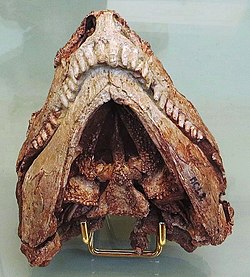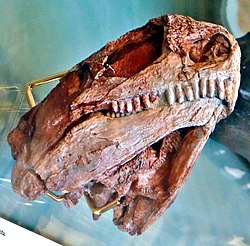Euromycter
Euromycter is an extinct genus of caseid synapsids that lived in what is now Southern France during the Early Permian (late Artinskian) about 285 million years ago.
It was collected by D. Sigogneau-Russell and D. Russell in 1970 at the top of the M1 Member, Grès Rouge Group, near the village of Valady (département of Aveyron), Rodez Basin.
[1] The species epithet refers to ruteni (Les Rutènes in French) the Latin name of the Gallic tribe that lived in the Rodez area.
[4][5] Characteristically, Euromycter shows an unusually broad skull, large temporal fenestra, and lack of expansion of the axial neural spine.
[9] A conclusion consistent with the magnetostratigraphy which suggests that the entire Grès Rouge Group (members M1 to M5) would have an age between the late Artinskian and the early Wordian.
[9] During a prospecting survey carried out in the Permian red sandstones outcropping in badlands on the western flank of the Cayla Hill (commune of Valady, northwest of Rodez), the paleontologists Denise Sigogneau-Russell and Donald Eugene Russell discovered in the summer of 1970 the skeletons of two herbivorous reptiles.
An eroded vertebra picked up on the western slope of the hill led the scientists to explore the surrounding canyons where they discovered a large articulated skeleton still in place in the sediments but damaged by erosion.
This animal was celebrated as the first caseid found in Western Europe, making of this species a geographical link with other specimens of the family that were previously known only in the south central United States (Texas and Oklahoma) and in the northern European Russia.
[1] In the first phylogenetic analysis of the caseids published in 2008, Euromycter, then still designated as “Casea” rutena, was recovered as the sister taxon to a derive clade containing Ennatosaurus tecton, Cotylorhynchus romeri and Angelosaurus dolani.


